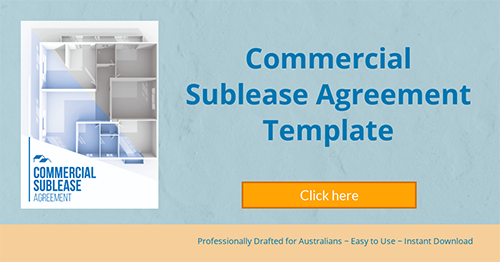This article is broken down into two sections:-
- The pros and cons to the sublessor (the person who is the tenant under the original lease and who is subleasing the whole or part of a premises to another);
- The pros and cons to the incoming sublessee (the person who is renting from the original tenant);.
Pros and Cons of being the Sublessor:
The pro’s of subleasing premises may include:-
- It’s economical. Subleasing helps to subsidise the high rents associated with retail and commercial property. The financial benefit of a rent source can be a real benefit, especially in times of hardship.
- Allows a business to downsize while still being able to afford the rent. If a business has downsized, subleasing part of the premises that is no longer being used will allow it to stay in the premises and ensures continued rent affordability. Ultimately, the tenant will save on costs that would otherwise have been incurred had they needed to break the lease and relocate to smaller premises.
- Allows a growing business to move on to larger premises. Subleasing old space allows business to move on to larger premises without breaking the lease and being hit with the associated costs. Another option in this situation is assigning or transferring your Lease.
The cons of subleasing premises may include:-
- You will still be 100% responsible to the landlord for rent and other obligations. What this means, is that if the subtenant defaults under the terms of the sublease, for example, by not paying rent or by damaging the premises, then it is you who will be liable to the landlord. However, you do have personal rights against the sublessee, making it possible to recover damages from them. Ultimately, though it is you who will be responsible to the landlord.
Alternatively, see assigning/transferring my Lease.
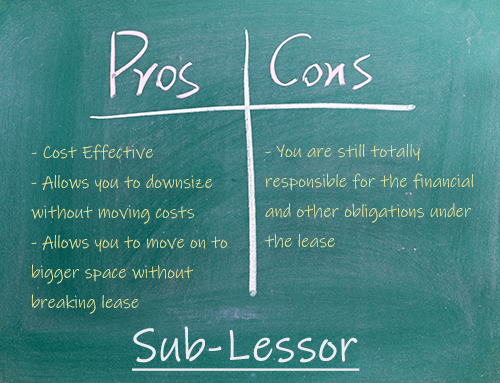
Pros and Cons of being the Sublessee
The pros of subleasing premises from the point of view of a sublessee include:-
- Cost effective. Rent, set up costs and on-going costs are often lower;
- It is often easier to qualify for a sublease;
- Subleasing allows a new business owner to start off small without committing to a larger space;
- The space is often already fitted out, so you can start operating straight away without the time and expense of fitting-out the premises;
- Access to shared spaces such as kitchen and toilet facilities;
- Fewer maintenance costs;
- You may be able to utilise shared services such as internet connections, reception services, office equipment and the like by paying an additional fee. This would mean set up costs to purchase such equipment and services are avoided.
The cons of subleasing premises include:-
- The Sublease is subject to the terms of the Lease that the sublessor has negotiated with their landlord. This could equate to a shorter tenancy term for the sublessee or terms or conditions which they would otherwise have not agreed to;
- Dependency on the sublessor. If the Head Lease is terminated early for any reason (such as a default of the sublessor), this could affect the sublease. Specific clauses should be included in your sublease to enable damages to be recovered from the sublessor in this event.
- Generally, alteration, improvement or fit-out options are restricted, which could limit the branding or signage that can be implemented by the subtenant.
It is up to you to weigh up the pros and cons as they may apply to your particular situation, keeping in mind that what may be seen as an advantage to one person, may be a distinct disadvantage to another.
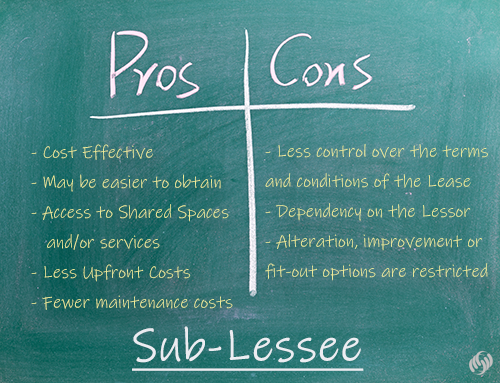
More information
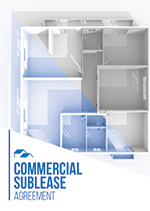 Commercial Sublease Agreement Template
Commercial Sublease Agreement Template
Use this template agreement to document the obligations of the sub-tenant and head-tenant.
Assignment of lease
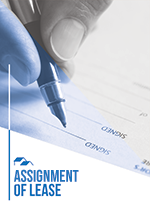 An Assignment of Lease Agreement (in some states referred to as a Transfer of Lease) transfers an existing tenant’s leasehold interest to the new tenant, creating rights and obligations as between the new tenant and the landlord.
An Assignment of Lease Agreement (in some states referred to as a Transfer of Lease) transfers an existing tenant’s leasehold interest to the new tenant, creating rights and obligations as between the new tenant and the landlord.
In effect, the new tenant agrees to step in and take over the existing tenant’s rights and obligations under the Lease. The new tenant becomes bound to the terms and conditions of the Lease, taking the place of the existing tenant, who is then released from it’s obligations as at the date of transfer. In this instance, a tenant who has assigned, or transferred, their leasehold interest will not be liable if the new tenant defaults.
How to sublease a Commercial or Retail Premises?
 Yes, you can sublease commercial or retail premises, provided that the terms of your Lease do not prevent you from doing so. If you wish to sublet part of your space then you need to follow the correct procedure so your sublease is approved by the Landlord.
Yes, you can sublease commercial or retail premises, provided that the terms of your Lease do not prevent you from doing so. If you wish to sublet part of your space then you need to follow the correct procedure so your sublease is approved by the Landlord.


